One Day In Macau: Itinerary For An Epic Day In Macau
Welcome to my Macau Travel Guide featuring a 1-day Macau itinerary with a budget to help you plan your trip.
When I arrived in Hong Kong I wasn’t actually planning to visit Macau. In fact, I read a lot of great reviews from other travelers so putting Macau on my bucket list may have seemed obvious. But no, the true reason why I went there was my friend’s friend. He offered us a tour around the island of Macau and the overnight stay in his flat. I thank him for the opportunity to visit this amazing city with Portuguese architecture on the other side of the planet.
Macau has a small area but a very dense population – staggeringly more than 20,000 people per square kilometer. It lies just an hour away across the South China Sea from Hong Kong by hover ferry. It encompasses three distinct areas- Mainland Macau and the two islands of Taipa and Coloane. They are connected to each other by a bridge and causeway respectively. Although the two territories are historically related, and have Cantonese speaking locals, the atmosphere of the two SARs (Special Administrative Regions) of China couldn’t be more different.
Macau’s history as a colonial outpost is much longer than Hong Kong. It was a Portuguese colony from 1557 until its return to China in 1999, two years after the Hong Kong handover. Macau still has some fine examples of Portuguese architecture and many of the street names and the shuttered windows of the old buildings reflect the influences from that nation.
One Day In Macau: Itinerary For An Epic Day In Macau
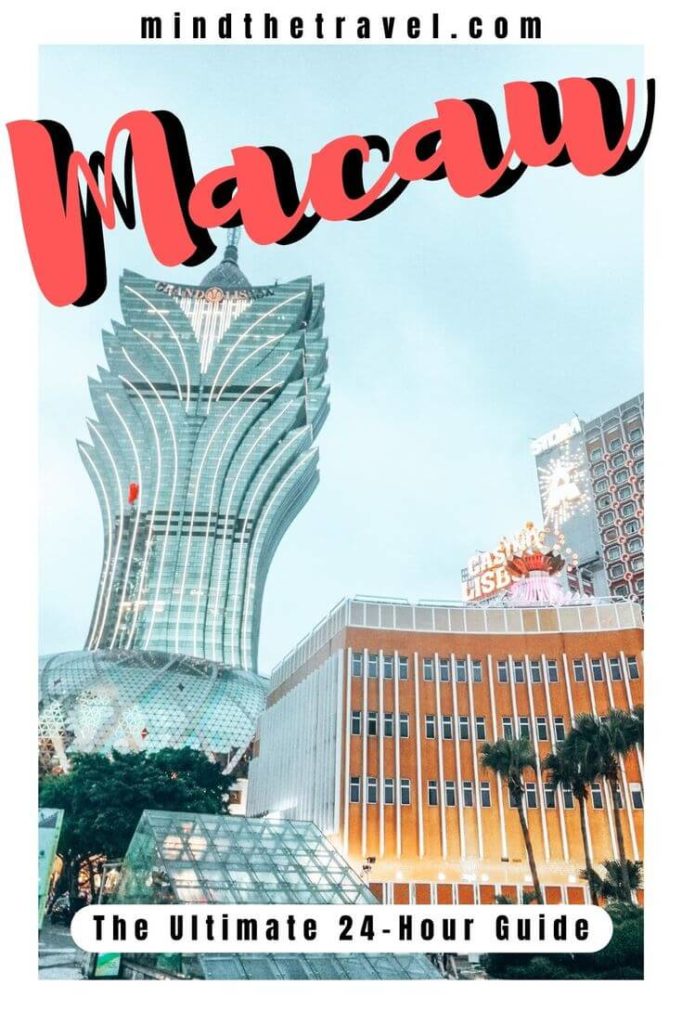
Macau In a Nutshell
Special Administrative Region has its own money, finance, customs, and legal system that are completely separate from China. The region even has its own snazzy flag. Like Hong Kong, Macau has a high degree of autonomy and greater liberties like a free press and an independent judiciary. It’s officially a part of China, though it has a full international border with the rest of the country.
The heart of Macau is dotted with glitzy hotels and casinos featuring wonderful architecture and design, many of them recreating cities like Paris, Venice, Rome, and New York. Macau’s posh hotels do their best to satisfy the needs and whims of visitors. They are often paired with shops, restaurants, rides, and long-running shows.
In fact, hotels and casinos are the biggest revenue generators in Macau, comprising about 40% of the economy. So, it’s no surprise why Macau is now dubbed as the “Gaming Capital of the World”, surpassing the legendary Las Vegas Strip.
Whether you’re into gambling or not, there are plenty of amazing things that you can see and experience in Macau. It is a perfect way to get in to the heart of Macau’s colonial past. I had a great time in Macau on my recent visit. You can explore the city in a day or more.
From its marvelous architecture to its mouth-watering food, the Portuguese legacy is particularly strong in Macau. I bet it will leave you guessing if you’re still in Asia. I’ve put together this Macau Travel Guide to help you plan your trip.
How to Reach Macau
Many people arrive in Macau from Hong Kong by fast ferry and at peak times they run at thirty-minute intervals. There is also an International airport in Taipa with direct flights to many cities in China and elsewhere in the region. It’s just a stone’s throw from the Taipa Ferry Terminal and bus routes. It takes approximately 35 minutes to Macau Peninsula city center by bus or about 17 minutes by taxi or car, depending on traffic.
Macau benefits from its proximity to China and many foot passengers arrive from the neighboring Chinese city of Zhuhai – one of Southern China’s Special Economic Zones.
Macau Airport to City Center
You have four options:
By Free Hotel Shuttles. Good news, folks! Most of the time, you won’t have to take the public buses because board any of the free shuttles provided by hotels to get to the city center. You don’t need to book any particular hotel to use the free shuttle. Even if you have no intention of staying there, you can still use it. Just pick the hotel closest to your destination. Check the bus schedule for the Venetian, Wynn Hotel, and City of Dreams.
By Free Airport Shuttle. The airport has its own free shuttle service. Once you clear immigration and customs, you will pass into the arrivals hall. Then find the north exit and make your way to the parking lot, where you’ll find the buses. Buses depart every 15-20 minutes. Service available from 11 am-9 pm.
By Public Bus. Fare is between MOP 4 and MOP 5. Check the public bus schedule here.
By Taxi. Taking a taxi makes sense when you need to reach parts of the city that are not easily accessible by bus. The flag-down rate is MOP 19 + MOP 2 for every 240 meters or every minute it’s not in motion. Additional MOP 3 charge for each piece of luggage in the compartment. The standard taxi fare from the airport to the city center is MOP 70-90, depending on which part of the city you’re traveling from.
Hong Kong to Macau by Ferry
If you’re traveling from Hong Kong, you can board the ferry to Macau. The voyage takes only around an hour. Fares are usually higher during the night and vary depending on the operator.
CotaiJet and TurboJet are the two main ferry companies operating between Hong Kong and Macau. You can hop on a ferry at any of these 3 terminals in Hong Kong:
China Ferry Terminal. Located next to Harbour City Mall in Tsim Sha Tsui, Kowloon. One-way ticket: HKD 135 to 175 (in the daytime) and up to HKD 211 (at night).
Hong Kong Macau Ferry Terminal (aka Sheung Wan Terminal). Situated on the third floor of Shun Tak Centre (next to the IFC Towers) on Hong Kong Island. One-way ticket: HKD 135 to 175 (in the daytime) and up to HKD 211 (at night).

Sky Pier. Located within walking distance of Hong Kong International Airport. One-way ticket: HKD 270.
There are two terminals in Macau where ferries from/to Hong Kong arrive and depart.
Macau Outer Harbour Ferry Terminal is the closest terminal to the city center. This one located on the peninsula.
Taipa Terminal sometimes referred to as Cotai Terminal, just a short walk from the airport and closer to the big hotels.
Hong Kong to Macau by Bus (Sea Bridge)
You can also hop on a bus to get to Macau from Hong Kong via the Hong Kong–Zhuhai–Macau Bridge (HZMB).
If your hotel is in Central Hong Kong or Tsim Sha Tsui (Kowloon) areas, I recommend the time-tested ferries because the ports are much closer. Taking the shuttle bus via sea bridge means you have to go to Lantau Island first, which means you need to take the MTR and then another bus. It can cause certain problems if you have heavy luggage in tow.
But if you really want to take a bus ride over the world’s longest sea bridge, there’s a way:
- Take the MTR to Sunny Bay Station.
- Board B5 Bus to HZMB in Lantau Island. Fare: HKD 5.8.
- Go through Immigration and Customs.
- Ride shuttle bus to Macau. The ticket office is after the Immigration and Customs area. Fare: HKD 65 (regular times), HKD 70 (midnight to 5-59am).
Macau Travel Guide to Getting Around
The Historic Center of Macau is home to many historic buildings, galleries, and museums that offer a way into its fascinating history and culture. There you’ll also find the Ruins of St. Paul’s, the Senado Square, and A-ma Temple. Macau is a very walkable city, and most interesting sites are within walking distance of each other. So don’t waste your money, walk when you can.
If you don’t feel like exploring Macau on foot, a good option is to take advantage of the free shuttle bus services provided by luxury hotels. They carry passengers (and potential gamblers) between the airport and Hong Kong ferry pier and the big casino hotels in Macau peninsula and Cotai. Of course, there are local bus services.
During my last visit to Macau, I rarely paid for transportation. I usually either just walk or hop on the free shuttle buses.
If you prefer using traditional taxis, these are relatively cheap and metered. You will have to know the Cantonese word for your destination or else have a Chinese friend write it for you – few Macanese taxi drivers speak English. For example, the taxi from Cotai Strip to Coloane was MOP 37, and MOP 49 from Coloane to Cunha Street. Quite a bargain, if you split the bill between 2 or 3 people. But of course, after free shuttles, buses are the best and cheapest way to get around Macau.
Also, it is still possible to ride on an ancient tricycle rickshaw in the downtown area. But these are becoming less common.
Best Time to Visit Macau
Having distinctive dry and wet seasons, Macau’s weather is dry and foggy in spring; hot and rainy in summer, cool and clear in autumn and cold but sunny during winters. The best time to visit Macau is in the Fall, from around mid- October till December, followed by Spring (March to early May). The months between May and September are the least comfortable and the temperatures can soar to 34 degrees with more than 90 percent humidity.
Macau has a subtropical climate and the summers become very hot and humid. Its location in the west of Pearl River between the mainland of China determines features of both continent and ocean climates.
Spring is also a great time to visit Macau. Spring in Macau runs from March to April when the southeast winds bring warmth and humidity. Other than the occasionally foggy and rainy weather, the days are sunny, and the night time temperatures are mild. You can pack your sweatshirts, light jackets, and umbrellas.
What to Expect in Macau. Things to Know About Macau Before Travelling
Macau Language: While Cantonese is the language of many Macanese, you are also certain to hear Mandarin spoken as there are many visitors from across the border. Around 90% of the population speaks Cantonese. You may also hear a few Europeans speaking Portuguese and see street names displayed in the MSAR’s two official languages, Cantonese and Portuguese. Some of the expatriates have remained in the territory.
Macau Currency: The region has its own currency – the Pataca (MOP) but Hong Kong dollars (HKD) and Chinese Yuan (RMB) are widely accepted. Keep in mind, some shops will only return changes in MOP and only accept 100 Chinese yuan banknotes. If you are coming for just a few days, just get HKD as it’s widely accepted and easy to exchange in your country. I’d discourage from using Chinese yuan in Macau because shops will not return the exchange rate difference, and only return MOP changes at face value.
Money Exchange: There are a lot of money changers throughout Macau. The most reputable companies are Soi Cheong Money Changer and P&W Casa de Cambio (aka Parkway Exchange), both of which have a branch in Senado Square.
How To Pay: Most establishments prefer cash payment, but many of them also accept credit card transactions.
Food in Macau
Macanese food has a large Portuguese influence and the enclave has many restaurants that still offer Portuguese cuisine. Macau’s reputation as a vibrant international hub means you can find the famous custard tarts, sticky pork buns, Chinese foods like dim sum and noodles, or unique fusion dishes that were created right in Macau through the many cultural influences coming through the trading routes.
Even the traditional Portuguese dishes taste entirely different in Macau because the first colonists to arrive tried to replicate their home food using Chinese techniques and ingredients and had to adapt the recipes. The result is peculiar and delicious and I love the fusion of cultures that shows on a single plate. Many consider Macanese food to be the world’s first fusion food.

The most famous restaurant is Fernando’s in Colonane. It gets very busy and you are advised to arrive early – it is not possible to book. Specialties include Portuguese sausage, Caldo Verdi soup, and fresh sardines washed down with Portuguese wine. Other parts of Macau have restaurants to cater for most tastes and of course, there is an abundance of Chinese restaurants of all cuisines.
Casinos And Gambling in Macau
Unlike Hong Kong, there are no gambling restrictions in Macau and to many, this is the main attraction. Huge investments have been made in the casinos and the territory has been appropriately dubbed “The Las Vegas of Asia”. There are numerous casinos dotted around Macau and Taipa – many linked to large and lavish hotels. China’s new wealth and Macau’s easy links to Hong Kong mean that big spenders come here.
One of the largest casinos in the world is the Venetian. Named for its indoor gondolas complete with singing gondoliers. These ply tourists around the massive indoor complex of shopping arcades and casinos in constant false twilight.
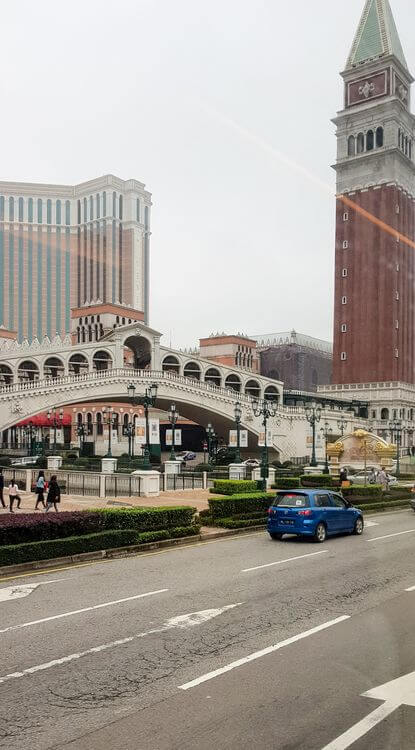
Many visitors spent their entire vacation in the resort’s A/C atmosphere and it is easy to lose track of time – something conductive to chancing your luck at the gaming tables. The Venetian has also become a venue for famous International cabaret acts. Macau’s economy is closely linked to the gambling industry and the Chinese are often avid gamblers staking thousands of dollars on games of roulette and blackjack.
Macau also boasts a horse racing track and is the venue for the Macau Grand Prix – which includes Formula Three and motorcycle races on a street track.
I’m not a gambler but visiting the Venetian was an event in itself. If you – just like me – don’t have extra money lying around, the casino still worth a visit, if just to people watch.
Things To Do in Macau
These are limited because of the size of the place but Macau’s location has presented it with a fascinating history. An excellent starting point is the Museum of Macau just a few minutes’ walk from St Paul’s. Here you can find all about Macau’s turbulent past. A particularly enjoyable exhibit is the one where life-size models of different tradesmen and women realistically shout their wares to attract customers. A short walk away you can reach the Municipal Park with its auspicious banyan trees and tai chi enthusiasts.
Close by is the historic Protestant cemetery where you can read the names of some of the British adventurers and missionaries who breathed their last a long way from home. Also on Mainland Macau, you can visit the A-ma temple which was erected long before the arrival of European invaders. It is always very well attended –perhaps with gamblers looking for good luck! It is dedicated to the goddess of the sea.
Taipa has little of interest other than casinos and restaurants. But Coloane still has a vestige of a sleepy colonial past with some pleasant beaches alongside fine examples of Portuguese architecture.
1. St Paul’s Church
A good starting point for wandering the crowded streets of Downtown Macau is from the façade of St Paul’s Church. This is a partially derelict Catholic church very centrally located. The side and back walls no longer exist but if you have the interest it is possible to enter the crypt and view dozens of human skeletons behind glass cases!
All taxi drivers will recognize a picture of the façade which is a symbol of Macau. The streets around St Paul’s are good for wandering and people watching. You can find some shopping bargains too. Notably wooden artifacts such as old rice or jewelry boxes and wooden furniture. I should say that most of them can easily be shipped abroad.
Bus Stop nearby the Ruins of St. Paul: Bus No. 10, 10A, 11, 21A, 2, 3, 3A, 4, 5, 6, 7, 8A, 26A, 33, 17, 18, 8A or 26
2. Monte Fortress (Fortaleza do Monte)
Monte Fortress is a military fortress built by the Portuguese colony during the 17th century to fend off pirates and intruders. Standing beside St.Paul’s Church and home to Macau Museum, the fort is built on the hilltop with solid walls up to 9 meters, overseeing the Macau peninsula. Monte Fortress is a popular attraction in Macau. You can have a panoramic view of the Macau peninsula on top of the fort. If you visit early in the morning you will most likely chance upon some locals practicing tai chi. Open daily from 7:00 am – 7:00 pm, no admission.
Bus Stop nearby Monte Fortress: Bus No. 7, 7A, 8, 17
3. Senado Square
No trip to Macau is complete without seeing Senado Square. It lies right in the heart of the old city adjacent to the Leal Senado Building. Senado Square is a UNESCO World Heritage Site boasting old colonial charm, ornate iron balconies, historic age-old buildings, churches, and delicious Macanese street food.
Bus Stop nearby Senado Square: Bus No. Bus No. 3, 4, 6 8A, 18A, 19, 26A, 33, N1A to Avenida de Almeida Ribeiro. Otherwise, hop on the free shuttle bus to Grand Lisboa and walk down Avenida de Almeida Ribeiro to reach Senado Square.
4. Macau Museum
Proudly standing on top of Monte Fortress, the Macau Museum is one of the few places where you can learn about the background of the city and how a Portuguese settlement came to exist here. Macau Museum exhibits the history of Macau as well as the different nationalities thriving here over the centuries. The Macau Museum Entrance Fee: MOP 15 (for free every 15th of the month). Open daily except Monday 10:00 am – 6:00 pm.
Bus Stop nearby Macau Museum: Bus No. 2, 3, 3A, 4, 5, 6, 7, 8A, 10, 10A, 11, 17, 18, 21A or 26.
5. A-Ma Temple
Despite all the unrelenting changes in Macau, the A-ma Temple retains its charm and remains a beautifully tranquil spot.

It was built in 1488 under the Ming Dynasty to honor of A-Ma, the goddess of the sea. The legend has it that the goddess helped fishermen and sailors to reach safety during a storm. Seafarers prayed to her to guide them during the journey.
Located in Largo do Pagode da Barra in the southeastern tip of the peninsula, the grounds around A-Ma Temple are divided into six areas. Open daily from 7 am – 6 pm.
Bus Stop nearby A-Ma Temple: No. 6, 8, 9 or 28B
1-Day Macau Itinerary. Visiting Macau from Hong Kong
Looking for a Macau 1-day itinerary? This Macau travel guide covers the best things to do in the city in one day so time is of the essence. If you want to make the most of your trip and pull off a more enjoyable, less stressful trip, then it’s best to visit places above in a certain order so you don’t waste too much time on a bus or shuttle. I have assembled this 1-day Macau backpacking itineraries to help you make the most of your time in this epic city.
7:00 am – 8:00 am Take a 7 am ferry from Sheung Wan or a 7.05 am ferry from Kowloon or a 7.40 am ferry from Tuen Mun. Arrive in Macau (Outer Harbour Ferry Terminal).
8:30 am – Breakfast at Senado Square. There’s a wide array of cafes and restaurants around Senado Square. For a local breakfast, look for an eatery that serves Portuguese or Macanese food. That said, a popular place for a Chinese breakfast is Sing Lei Cha Chaan Teng. For Portuguese egg tarts, try Choi Heong Yuen Bakery or Margeret’s Café.
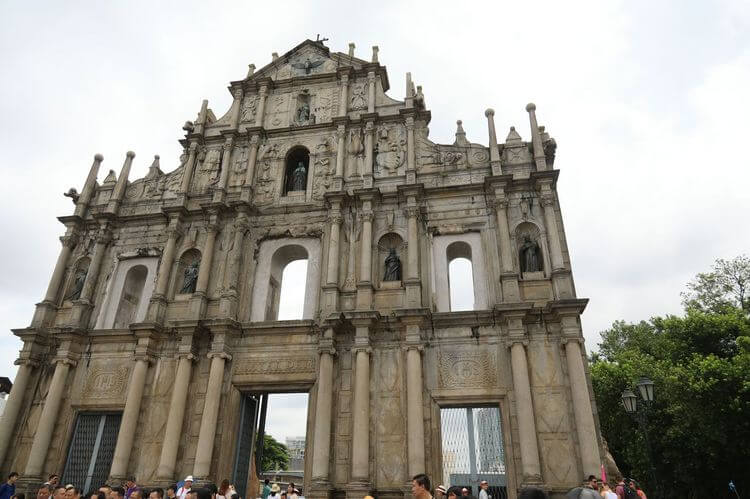
You Will Also Like: Travel Itinerary for One Week in Beijing
10 am – Wander around the historic center and explore Macau’s top attractions. Spend some time in Senado Square and check out the surrounding attractions clustered in a small area, which are easy to explore on foot. Make sure to visit St. Dominic’s Cathedral, Ruins of St. Paul’s, and Monte Fort with Museum of Macau.
1 pm – A Macanese lunch. Just a stone’s throw from the Monte Fortress there is Cafe de Novo Tomato. They serve traditional Portuguese food at reasonable prices. So if you want to try some traditional Portuguese food and you don’t want to spend so much on it, give Cafe de Novo Tomato a try.
2 pm – Climb the steep stone steps at A-Ma Temple. Dedicated to the Taoist goddess of seafarers, A-Ma Temple’s first pavilions and halls were built by fishermen 600 years ago. It was one of the first landmarks sighted by Portuguese traders. If you have time, near the temple is the Maritime Museum where you can learn Macau’s long-standing sea traditions, know the stories of its fishermen and their families, and the role Macau played in the trade of Chinese silk and Japanese silver during the 17th century.
3.30 pm – Macau Tower. After eating near the square, it’s time to climb Macau Tower. Located on the southern end of the peninsula, the tower stands 338 meters tall, providing the most impressive panoramic views of Macau. A quick visit to Macau Tower will give you a bird’s-eye view of the city from high above. They also have a skywalk and bungee jumping from up there if you dare!
5 pm – House of Dancing Water. This is Macau’s most famous show and a truly amazing performance you may want to squeeze in your one day Macau itinerary. The House of Dancing Water is a massive performance by Cirque du Soleil’s producer featuring acrobats with dancers, performers, and lots of water. The downside is that the show is quite expensive so you may prefer to skip it. They usually have 5 pm and 8 pm shows so I recommend going to the one at 5 pm to get out on time for dinner. If you choose to skip the show, I would recommend you have a sunset drink at the Cheoc Van Beach and an earlier dinner at one of the options below.
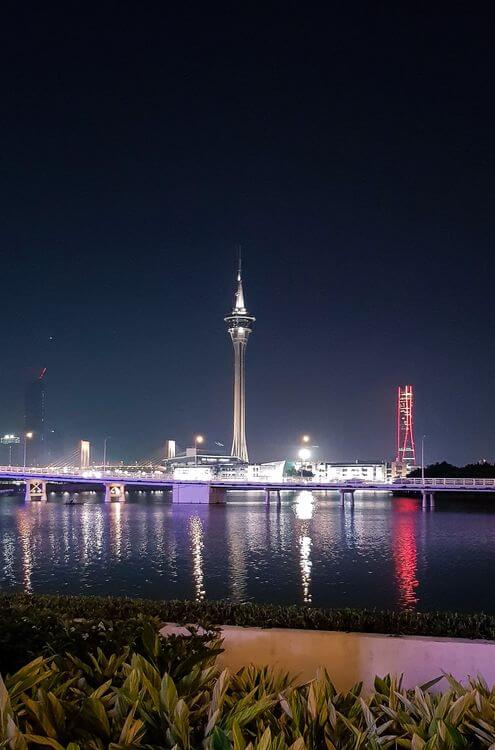
Read Next: Things Nobody Tells You About Visiting Beijing
7 pm – Dinner in Macau. After the show (or a relaxing stroll along the beach), hit the bars and restaurants on the Cotai Strip. The highlight is Lord Stow’s Bakery if you like Portuguese Egg Tarts. Even if you don’t like or know about them, it’s worth a try.
Whether you’re in the mood for upscale French cuisine at the Tasting Room or exciting private dining rooms at two Michelin starred Chinese restaurant Jade Dragon, the City of Dreams has got you covered.
But, of course, there are also budget-friendly restaurants serving Chinese and Macanese food. Alternatively, you can have dinner at one of the hotel buffets.
9 pm – Explore the Cotai Strip. After dinner, do some more exploring or go casino hopping. Place a bet if you’re feeling lucky. But I recommend wandering around the Cotai Strip to ogle at the luxury shopping malls and bright lights. All the Cotai hotels have a roster of events, shows, and festivals throughout the year. For instance, at the Parisian Eiffel Tower Light Show starts at 6.15 pm and lasts until midnight, every 15 minutes.
11 pm – 11:59 pm – Taipa Ferry Terminal. Catch a shuttle from the Taipa Ferry Terminal. The last ferry from Taipa to Sheung Wan leaves at 23:59 (11:59 pm).
How Much To Budget For A Day In Macau
I went to Macau mainly because I had an opportunity to stay at my friend’s flat for free. Therefore, the brunt of my spending went to ferry tickets and food. I wasn’t eating fancy meals at expensive restaurants, so I wound up spending around HKD 800 for the day, including two taxi rides.
If you don’t want to spend too much on food and are happy using the free shuttles and public buses, then a budget of around HKD 700 for the entire day should be enough. It should cover just the bare minimum of roundtrip ferry tickets, meals, and some trinkets.
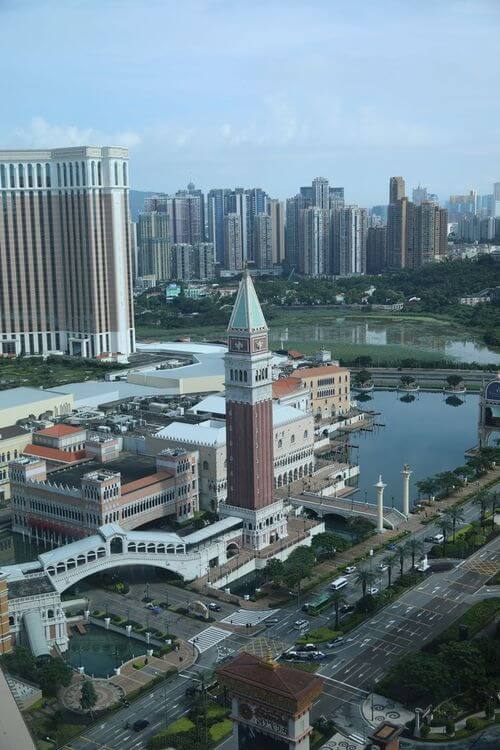
If you plan on discovering some of the best activities and attractions Macau has to offer, including watching shows, doing any shopping or gambling, then feel free to adjust. Depending on the number of people in your group, I don’t think you can spend a day in Macau for considerably less than HKD 600 since over half of that will go to roundtrip ferry tickets.
Where to Stay in Macau
If you’re too tired and thinking about staying overnight, there’s nothing wrong with that. While Macau is best known for its luxurious hotels, the city is also home to cheap alternatives to hotels. These options are concentrated in the Macau peninsula, around the city center. You can find budget hotels, guesthouses, and even hostels within and in the outskirts of the historic center. Keep in mind, hotel rates usually increase on weekends and surge during peak seasons.
There are lots of great places to stay in Macau but here are some of my top picks:
The Bottom Line
Like Shanghai, Macau was one of the most incredible experiences I had in my life. Apart from gambling and casinos, it has a rich blend of cultures to discover and outstanding food to try. You can combine a visit to Macau with a trip to Hong Kong to get the most out of your trip. Taking the ferry is a convenient and easy way to reach Macau as a side tour from Hong Kong. Macau is an interesting place to spend a few days on your travels through China. I would recommend spending at least two days in Macau to feel the spirit of this place.
PIN IT FOR LATER!



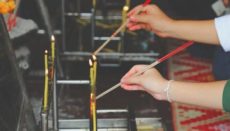

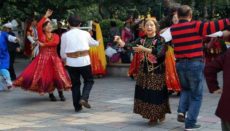
Sorry, the comment form is closed at this time.